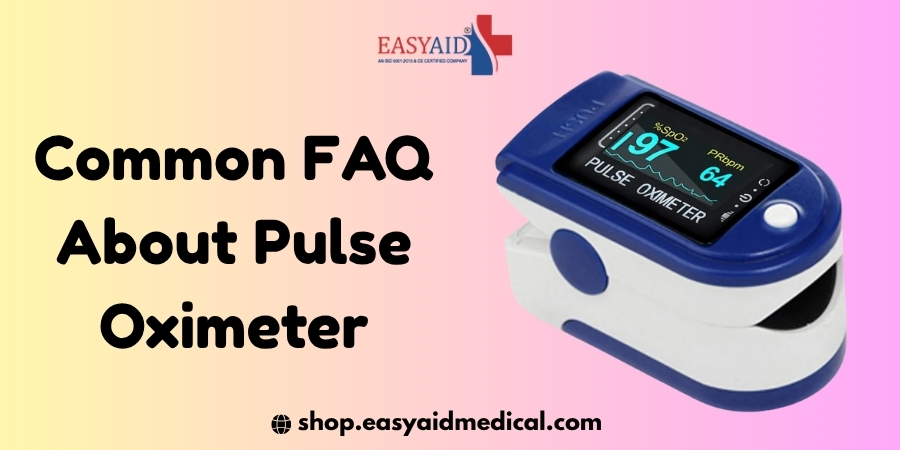1. What is a pulse oximeter?
A pulse oximeter is a small, portable medical device used to measure the oxygen saturation (SpO₂) level in your blood and your pulse rate. It clips onto your fingertip and provides quick, non-invasive readings.
2. How does a pulse oximeter work?
The device uses infrared and red light sensors to detect how much oxygen is carried in the blood. The light passes through your finger, and the device calculates your oxygen level and heart rate based on light absorption patterns.
Also Read- Importance of walking for men
3. What is a normal oxygen level reading?
For healthy adults, the normal SpO₂ reading typically ranges between 95% and 100%. Readings below 94% may indicate low oxygen levels (hypoxemia), and you should consult a doctor if it persists.
4. When should you use a pulse oximeter?
A pulse oximeter is useful in several conditions, such as:
- Monitoring respiratory illnesses like asthma or COPD.
- Checking oxygen levels during COVID-19 recovery or flu.
- Evaluating fitness and altitude training for athletes.
- Monitoring patients with sleep apnea or heart conditions.
5. Can I use a pulse oximeter at home?
Yes, a pulse oximeter is designed for easy home use. It is widely used by individuals to monitor oxygen levels daily, especially for those with respiratory or cardiac issues.
6. How accurate are pulse oximeters?
Medical-grade pulse oximeters are typically 95–99% accurate when used properly. However, accuracy may vary based on skin temperature, nail polish, poor circulation, or improper fitting.
7. How do I use a pulse oximeter correctly?
- Sit still and relax for a minute.
- Clip the oximeter on your index or middle finger.
- Wait for 5–10 seconds for the reading to stabilize.
- Record your SpO₂ and pulse rate.
Avoid using it under bright sunlight, or when your hands are cold.
Also Read- Common FAQ About Medical Bed Bath Towel
8. What factors can affect pulse oximeter readings?
- Nail polish or artificial nails
- Cold fingers or poor blood circulation
- Excessive movement during measurement
- Strong ambient light
- Weak battery or low-quality sensors
9. What are the types of pulse oximeters available?
- Fingertip Pulse Oximeters – Most common, for home and clinical use.
- Handheld Pulse Oximeters – Used in hospitals for higher precision.
- Wrist Pulse Oximeters – For continuous monitoring, often during sleep studies.
10. Who should regularly use a pulse oximeter?
It is especially useful for:
- People with respiratory diseases (COPD, asthma, pneumonia).
- COVID-19 patients or those recovering from it.
- Elderly individuals with heart or lung conditions.
- Athletes involved in endurance training or high-altitude sports.
11. Are pulse oximeters reusable?
Yes. Most oximeters are reusable for personal use. Clean the sensor area gently with 70% isopropyl alcohol before and after use, especially if shared between individuals.
12. Do pulse oximeters measure heart rate too?
Yes, nearly all modern pulse oximeters show both oxygen saturation (SpO₂) and pulse rate (bpm), giving you a quick overview of your cardiovascular health.
13. Can pulse oximeters detect heart attacks?
No. A pulse oximeter only measures oxygen saturation and pulse rate. It cannot detect or predict heart attacks or other cardiac abnormalities directly.
14. What are some popular pulse oximeter brands in India?
Some reliable brands include Dr. Trust, BPL, Omron, Beurer, Rossmax, and EasyPulse. These are widely available both online and in medical stores.
15. How should I store my pulse oximeter?
Keep it in a dry and cool place, away from direct sunlight and moisture. Remove batteries if you’re not using it for a long time to prevent corrosion.
16. Is a pulse oximeter suitable for children?
Yes, but use pediatric-specific models for more accurate readings. Adult oximeters may not fit properly on smaller fingers and can give inaccurate results.
17. How long does a pulse oximeter last?
A well-maintained pulse oximeter can last for 2–5 years depending on build quality, usage frequency, and care.

